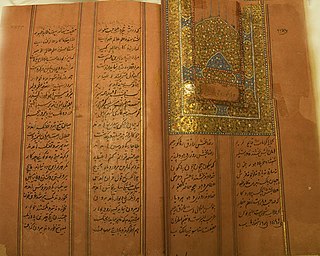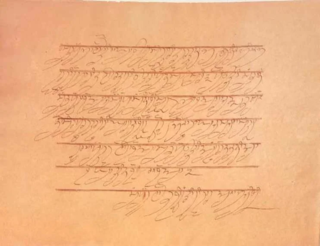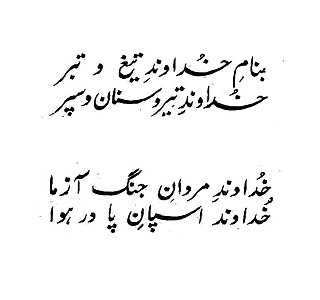
Guru Gobind Singh was the tenth and last human Sikh Guru. He was a warrior, poet, and philosopher. In 1675, at the age of nine he was formally installed as the leader of the Sikhs after his father Guru Tegh Bahadur was executed by Emperor Aurangzeb. His father was the ninth Sikh Guru. His four biological sons died during his lifetime – two in battle and two executed by the Mughal governor Wazir Khan.
The following outline is provides an overview of Sikhism, or Sikhi.

The Dasam Granth is a collection of various poetic compositions attributed to Guru Gobind Singh. The text enjoyed an equal status with the Adi Granth, or Guru Granth Sahib, in the eighteenth and nineteenth centuries and were installed side by side on the same platform. The Dasam Granth lost favor during the colonial period when reformist Singh Sabha Movement scholars couldn't contextualize the reworkings of Puranic stories or the vast collection of 'Tales of Deceit' Sri Charitropakhyan.

The Zafarnāma was a spiritual victory letter sent by Guru Gobind Singh in 1705 to the Mughal Emperor of India, Aurangzeb, after the Battle of Chamkaur.

The Nihang or Akali, also known as Dal Khalsa, is an armed Sikh warrior order originating in the Indian subcontinent. Nihangs are believed to have originated either from Fateh Singh and the attire he wore or from the "Akal Sena" started by Guru Hargobind. Early Sikh military history was dominated by the Nihang, known for their victories where they were heavily outnumbered. Traditionally known for their bravery and ruthlessness in the battlefield, the Nihang once formed the irregular guerrilla squads of the armed forces of the Sikh Empire, the Sikh Khalsa Army.

Bhai Mani Singh was an 18th-century Sikh scholar and martyr. He was a childhood companion of Guru Gobind Singh and took the vows of Sikhism when the Guru inaugurated the Khalsa in March 1699. Soon after that, the Guru sent him to Amritsar to take charge of Harmandir Sahib, which had been without a custodian since 1696. He took control and steered the course of Sikh destiny at a critical stage in Sikh history. He was also a teacher of the Gianian Bunga, later becoming known as the "Amritsari Taksal", currently located in Sato Ki Gali.
Daya Singh was one of the Panj Pyare, the first five Sikhs to be initiated into the Khalsa order in 17th-century India. Among the inaugural panj piare quintet, he is traditionally the highest-regarded as he was the first to answer the call for a sacrifice from the guru. Daya Singh was an educated Sikh, with literature being attributed to his authorship.

Fateh Singh, commonly referred to with honorifics as Baba Fateh Singh or Sahibzada Baba Fateh Singh, was the fourth and youngest son of Guru Gobind Singh.
Machhiwara is one of the developing cities in the Ludhiana district of the Indian state of Punjab. Machhiwara is famous for Gurudwara Sri Charan Kanwal Sahib associated with Guru Gobind Singh ji and named after the Guru's feet that are compared to the lotus flower. And It is also famous for Religious Hindu Sri Shivala Bramchari Temple associated with the Pandavas of Dvapara Yuga.

Chandi Di Var also known as Vaar Durga Ki is a composition written by Guru Gobind Singh, included in the 5th chapter of Dasam Granth.

The Battle of Chamkaur, also known as Battle of Chamkaur Sahib or the Second battle of Chamkaur, was fought between the Khalsa, led by Guru Gobind Singh, and the coalition forces of the Mughals led by Wazir Khan and Hindu hill chiefs. Guru Gobind Singh makes a reference to this battle in his letter Zafarnama.

The Battle of Nadaun, alternatively known as the Hussaini Yudh, was fought at Nadaun, between Raja Bhim Chand of Bilaspur (Kahlur) and the Mughals under Alif Khan. Bhim Chand was supported by Guru Gobind Singh and the Mughals were supported by other hill chieftains, notably Kirpal Chand from Kangra and Dayal Chand from Bijharwal. Bhim Chand and some hill chieftains, after conclusion of Battle of Bhangani had refused to pay tribute to the Mughal emperor which led to the battle at Nadaun. The battle resulted in the victory of Bilaspur State and Sikh alliance.
Manuke is a village on Guru Gobind Singh Marg (highway) in district Ludhiana, state of Punjab, India. It is one of the largest village in Jagraon block. The world-famous Gurdwara Mehdiana Sahib is situated outside the village on the west. The village is populated mostly by Sandhu families. It has two main Gurdwara's, Shivdwala, and a Maseet. One of the Gurdwaras, Patshahi Dasvee, is believed to have been visited by Guru Gobind Singh himself while he was en-route to the Lakhi Jungle. The village has built a state of the art modern funeral home.

Shabad Hazare, also known as Sabad Patshahi 10, under the title Shabad, are ten religious hymns composed by Guru Gobind Singh that are present in Dasam Granth. These hymns have comments on ritualistic practices in Sanyas, Jogis and Bairagis, and also against any form of idolatry, human or deity worship.

Sikhism in Bangladesh has an extensive heritage and history, although Sikhs had always been a minority community in Bengal. Their founder, Guru Nanak visited a number of places in Bengal in the early sixteenth century where he introduced Sikhism to locals and founded numerous establishments. In its early history, the Sikh gurus despatched their followers to propagate Sikh teachings in Bengal and issued hukamnamas to that region. Guru Tegh Bahadur lived in Bengal for two years, and his successor Guru Gobind Singh also visited the region. Sikhism in Bengal continued to exist during the colonial period as Sikhs found employment in the region, but it declined after the partition in 1947. Among the eighteen historical gurdwaras in Bangladesh, only five are extant. The Gurdwara Nanak Shahi of Dhaka is the principal and largest gurdwara in the country. The Sikh population in the country almost entirely consists of businessmen and government officials from the neighbouring Republic of India.

Fatehnama, also known as Namah-i-Guru Gobind Singh or the Jangnamah is a Persian composition attributed to Guru Gobind Singh. It was contained within the Dasam Granth.

Lakhi Jungle was a historical jungle located in present-day Punjab, India. It should not be confused with the historical Machhiwara jungle.

Mittar Pyare Nu is a Shabad attributed to Guru Gobind Singh in Machhiwara after the Battle of Chamkaur.















